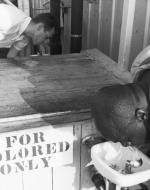Created by Lora Fernandez on Wed, 11/17/2021 - 21:24
Description:
After centuries of racial discrimination, segregation within education became a hot topic for many years. In the court ruling of Plessy vs. Ferguson, the concept of “separate but equal” was pushed upon society. It acted as a “band-aid,” masking itself as progress and a step closer towards equality. However, many began to quickly find that this ruling only excused blatant racist and discriminatory behaviors. African Americans can go to school, but it will be significantly less funded and poorly ran. African Americans can drink out of the fountain, but it will be of poor quality and less appealing. “Separate but equal,” only created a more significant and blatant division among Americans and specifically among races. These ideals drove America to the next stage which was established by the Brown vs. Board of Education. This fought strongly against the fundamental believes of Jim Crow doctrine and other racially driven laws. Brown vs. Board of Education fought for equality within schools and the right to an equal education. People began to fight more as they began to see a hopeful future. People such as Ruby Bridges and Jane Elliott were both huge figures during this time as they fought for a better future for equal education.
Wolff, K. (2021). 82.03.06: From Plessy v. Ferguson to Brown v. Board of education: The Supreme Court rules on school Desegregation. Yale-New Haven Teachers Institute. https://teachersinstitute.yale.edu/curriculum/units/1982/3/82.03.06/2


